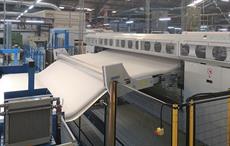
"Carbon fibre is expensive. It is also energy intensive to make, so it is not exactly greenhouse gas (GHG) friendly. Making carbon fibre readily recyclable could help in both these regards," said National Renewable Energy Laboratory (NREL) scientist Nicholas Rorrer.
Through a project supported by the US department of energy's vehicle technologies office, under the composites core programme, Rorrer and other NREL researchers have shown that making carbon fibre composites with bio-based epoxies and an anhydride hardener makes the material fully recyclable by introducing linkages that are more easily degraded. In fact, the recycling process—called methanolysis—can be selectively triggered at room temperature without degrading the quality or orientation of the fibres. That could represent a strong step toward a circular material, which can make carbon fibre cheaper and greener when used across multiple lives.
Rorrer and teammates began experimenting with the chemistry of biomass to understand if it could enable a new epoxy designed for recyclability. Compared to the hydrocarbons in petroleum, biomass contains higher levels of oxygen and nitrogen, offering a different set of chemical possibilities.
"We essentially redesigned the epoxy amines resins—today's thermosets in carbon fibre—with epoxy and anhydrides synthesized from biomass, predominantly from the biological and chemical conversion of sugars," Rorrer explained. "We have shown that that reformulated resin can maintain and/or exceed all the same properties as in today's epoxy amine resins, but also make them recyclable by design—and at room temperature."
Using a special catalyst, the NREL team was able to break down the bio-based resin at room temperature, a process known as "depolymerisation." That allowed them to recover the carbon filaments while maintaining their quality and alignment.
"We can actually maintain the fibre quality over at least three material lives," Rorrer said. "So not only are we able to recycle it; we are able to recycle it without any detriment to properties. We are not downcycling the material at all."
Being able to extract and recycle the carbon fibre could make the material more economical for mass market electric vehicles, freeing up weight and space for batteries. It would also lower the material's GHG footprint by 20–40 per cent. Better yet, it could achieve all that without increasing manufacturing costs, as Rorrer estimates NREL's epoxy could be produced for roughly the same price as today's petroleum-based epoxy-amine resins.
"By using bio-based feed stocks instead of petrochemical feedstocks, we don't have to use extra energy to dramatically retool their chemistries," Rorrer added. "That allows us to more precisely, cheaply, and effectively design advanced materials with performance and environmental advantages."
Fibre2Fashion News Desk (RR)

